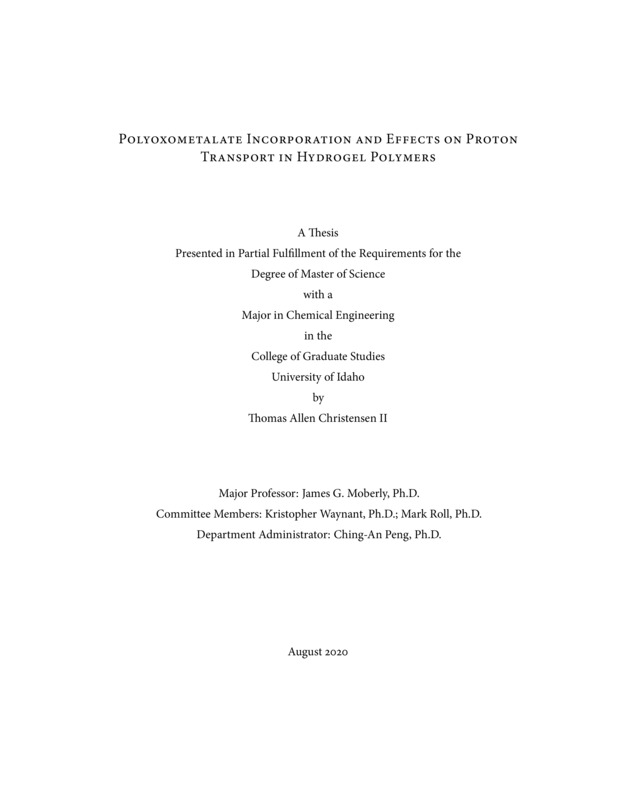Polyoxometalate Incorporation and Effects on Proton Transport in Hydrogel Polymers
Christensen II, Thomas Allen. (2020-08). Polyoxometalate Incorporation and Effects on Proton Transport in Hydrogel Polymers. Theses and Dissertations Collection, University of Idaho Library Digital Collections. https://www.lib.uidaho.edu/digital/etd/items/christensenii_idaho_0089n_11912.html
- Title:
- Polyoxometalate Incorporation and Effects on Proton Transport in Hydrogel Polymers
- Author:
- Christensen II, Thomas Allen
- ORCID:
- 0000-0003-1219-9320
- Date:
- 2020-08
- Keywords:
- bioremediation polyoxometalate
- Program:
- Chemical and Materials Science Engineering
- Subject Category:
- Chemical engineering
- Abstract:
-
Polyoxometalate clusters embedded into hydrogel biobeads may be able to solve
the challenges posed by free proton generation during remediation of
trichloroethylene by acting as buffers and reducing protons to hydrogen gas. In
this thesis, the challenges posed by systems that contain both diffusion and
reaction processes for protons are considered mathematically, and a computer
simulation to was developed to prove the relationship between diaphragm cell lag
period and reactive capabilities of membranes. Two polyoxometalate compounds,
sodium decavanadate and alumina sulfate, were successfully incorporated into a
poly(vinyl alcohol) hydrogel membrane, and the diffusivity changes associated
with each compound was determined. It was found that the diffusivity of protons
through an unmodified 10\% w/v poly(vinyl alcohol) membrane was $ 1.76 \times
10^{-5} \ \textup{cm}^2\ \textup{s}^{-1}$, the diffusivity through a 10\%/2\%
w/w/v poly(vinyl alcohol)/sodium decavanadate membrane was $ 3.10 \times 10^{-6}
\ \textup{cm}^2\ \textup{s}^{-1}$, and the diffusivity through a 10\%/2\% w/w/v
poly(vinyl alcohol)/alumina sulfate membrane was $ 3.32 \times 10^{-7} \
\textup{cm}^2\ \textup{s}^{-1} $. Through analysis of the diaphragm cell lag
period, it was found the incorporation of sodium decavanadate did not increase
the reactivity of a poly(vinyl alcohol) hydrogel, and incorporation of alumina
sulfate lowered the reactivity. These results indicate that polyoxometalate
integration into hydrogel membranes is feasible, but does not provide any
advantage to a bioremediation scenario.
- Description:
- masters, M.S., Chemical and Materials Science Engineering -- University of Idaho - College of Graduate Studies, 2020-08
- Major Professor:
- Moberly, James G
- Committee:
- Waynant, Kristopher; Roll, Mark
- Defense Date:
- 2020-08
- Identifier:
- ChristensenII_idaho_0089N_11912
- Type:
- Text
- Format Original:
- Format:
- application/pdf
- Rights:
- In Copyright - Educational Use Permitted. For more information, please contact University of Idaho Library Special Collections and Archives Department at libspec@uidaho.edu.
- Standardized Rights:
- http://rightsstatements.org/vocab/InC-EDU/1.0/

